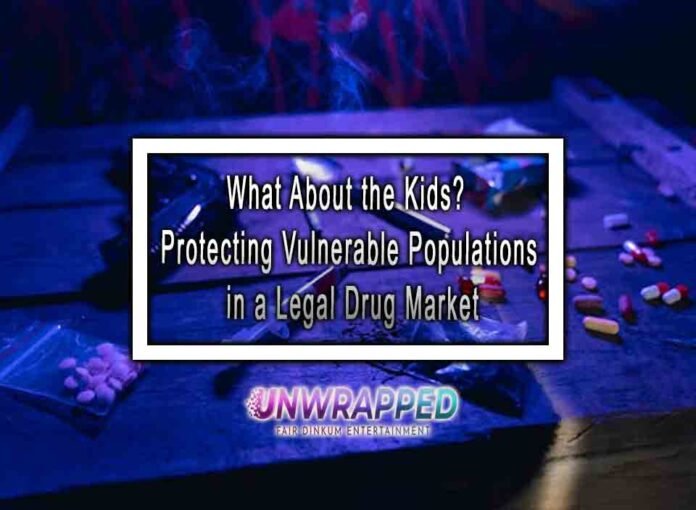What About the Kids? Protecting Vulnerable Populations in a Legal Drug Market
As countries move toward legalizing drugs, a central concern is how to protect vulnerable populations, especially children and at-risk individuals. A well-regulated drug market must include robust measures to prevent youth access, minimize harm, and ensure that vulnerable groups are not disproportionately affected. This article explores strategies to safeguard these populations in a legal drug market, drawing from successful policies and evidence-based approaches.
Challenges in Protecting Vulnerable Populations
1. Increased Accessibility
Legalization makes drugs more widely available, raising concerns about potential exposure to minors and at-risk individuals.
2. Normalization of Use
Legal markets may unintentionally signal that drug use is safe or acceptable, particularly to impressionable young people.
3. Socioeconomic Vulnerability
Communities historically impacted by drug prohibition may face new challenges, such as targeting by marketing or unequal access to education and treatment resources.
Key Measures to Protect Youth and At-Risk Populations
1. Strict Age Restrictions
A. Legal Age Requirements
Set minimum age limits for purchasing and using drugs, mirroring existing restrictions for alcohol and tobacco:
- Example: Canada’s cannabis laws prohibit sales to individuals under 19 in most provinces (Health Canada).
B. Enforceable Penalties
Impose severe penalties on retailers or individuals caught selling drugs to minors:
- License revocation for businesses.
- Heavy fines and potential legal action for violations.
2. Responsible Marketing Practices
A. Advertising Restrictions
Prohibit advertising that targets or appeals to minors:
- Ban advertisements featuring cartoons, bright colors, or messaging that glamorizes drug use.
- Require plain packaging with clear warnings and educational labels.
Case Study: Uruguay mandates plain packaging and prohibits cannabis advertising to minimize youth appeal (Uruguay Drug Observatory).
B. Sponsorship and Public Events
Restrict drug companies from sponsoring events frequented by young people, such as music festivals or sports competitions.
3. Education and Prevention Programs
A. School-Based Education
Introduce evidence-based drug education curricula in schools:
- Focus on decision-making, peer resistance, and the long-term consequences of substance use.
- Avoid scare tactics in favor of factual, relatable information.
Example: Portugal’s school programs emphasize harm reduction and informed decision-making, contributing to stable drug use rates among youth (Transform Drug Policy Foundation).
B. Public Awareness Campaigns
Run nationwide campaigns to educate families about the risks of drug use:
- Promote open, stigma-free discussions between parents and children.
- Highlight the importance of delaying first use until the brain is fully developed.
4. Regulating Product Access
A. Age Verification Technology
Mandate strict age verification processes at the point of sale, both in-person and online:
- Require government-issued ID for purchases.
- Use facial recognition or secure digital platforms for online sales.
B. Retail Zoning
Limit the location of drug retail outlets to reduce exposure to minors:
- Prohibit stores near schools, playgrounds, or residential areas with a high density of children.
Case Study: Colorado requires cannabis dispensaries to maintain a minimum distance from schools and daycare centers (Colorado Department of Revenue).
5. Supporting At-Risk Individuals
A. Accessible Treatment and Support Services
Ensure vulnerable populations have access to addiction treatment, mental health care, and harm reduction services:
- Expand availability of rehabilitation centers.
- Provide subsidies or free access to treatment for low-income individuals.
Example: Canada uses cannabis tax revenue to fund addiction treatment and mental health initiatives (Health Canada).
B. Community Reinvestment
Use tax revenue from drug sales to support programs in underserved communities:
- Fund job training, education, and healthcare services.
- Address underlying issues such as poverty and unemployment that increase vulnerability to drug misuse.
Case Study: Illinois allocates 25% of cannabis tax revenue to a restorative justice fund supporting communities affected by the War on Drugs (Illinois Department of Revenue).
Monitoring and Adjusting Policies
1. Data Collection
Regularly monitor the impact of legalization on vulnerable populations:
- Youth Use Rates: Track changes in drug use among minors through surveys and health data.
- At-Risk Outcomes: Measure rates of addiction, mental health issues, and access to treatment services.
2. Continuous Policy Refinement
Use data to refine regulations and address gaps:
- Tighten age verification processes if underage use is detected.
- Expand education programs based on community feedback.
Example: Canada continuously adjusts its cannabis policies based on annual reports and public health data (Health Canada).
Global Lessons on Protecting Vulnerable Populations
1. Portugal: A Health-Focused Approach
Portugal’s decriminalization model includes comprehensive harm reduction programs, accessible treatment, and youth education, resulting in stable youth drug use rates and improved public health outcomes (Transform Drug Policy Foundation).
2. Uruguay: A State-Controlled Market
Uruguay’s government-managed cannabis system prioritizes public safety by regulating access, prohibiting advertising, and ensuring product safety. This approach has minimized youth exposure and black market activity (Uruguay Drug Observatory).
3. Colorado: Comprehensive Regulation
Colorado’s cannabis legalization framework includes zoning restrictions, education campaigns, and strict age verification processes, effectively preventing youth access (Colorado Department of Revenue).
A Vision for Protection
Legalization doesn’t mean abandoning vulnerable populations—it means creating systems to protect them better. A well-regulated market prioritizes:
- Preventing youth access through strict enforcement and education.
- Supporting at-risk individuals with accessible treatment and harm reduction services.
- Investing in communities to address the root causes of vulnerability.
By learning from successful models and continuously refining policies, governments can ensure that legalization works for everyone, especially the most vulnerable.
References
- Transform Drug Policy Foundation
Portugal’s Decriminalization Success - Health Canada
Cannabis Regulation and Youth - Colorado Department of Revenue
Cannabis Regulations and Public Safety - Uruguay Drug Observatory
Cannabis Regulation and Youth Protection - Illinois Department of Revenue
Cannabis Tax Revenue and Community Investment
See Also: Legalization vs. Decriminalization: Understanding the Difference and Why It Matters
A Brave New World: Envisioning a Society Free from the War on Drugs










